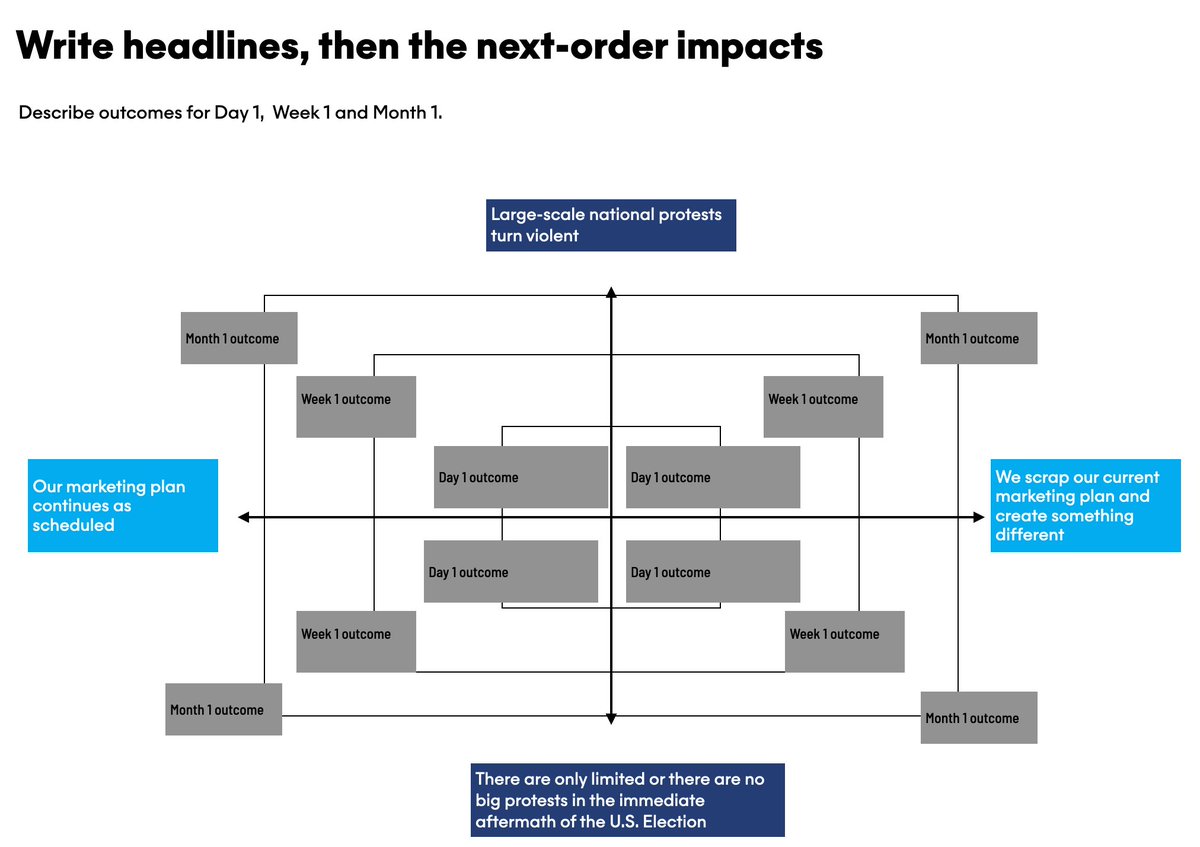We will see more bizarre stories like this during the next few weeks. This is another strong signal about election next-order outcomes.
Futurists use an important framework in times like this, and I want to share it with you now to help you prepare for what& #39;s next. (1/many) https://twitter.com/sarahparvini/status/1315790358605824001">https://twitter.com/sarahparv...
Futurists use an important framework in times like this, and I want to share it with you now to help you prepare for what& #39;s next. (1/many) https://twitter.com/sarahparvini/status/1315790358605824001">https://twitter.com/sarahparv...
2 - As of this moment, we cannot be certain about the outcome of the U.S. election — but there are now enough strong signals in play that we can forecast contested results.
If you are the leader of your team or organization, NOW is the time to ask “what’s plausibly next?”
If you are the leader of your team or organization, NOW is the time to ask “what’s plausibly next?”
3 - There are two ways to figure out the immediate outcomes of a contested election and how that could impact your organization: (1) a well-designed Monte Carlo simulation and (2) heuristic contingency scenarios.
4 - If you’re curious about questions that are more quantitative — should we adjust our Q4 financial models right now? will we hit our sales targets for November and December? should we focus on process A or process B? — then Monte Carlo works.
5 - Monte Carlo simulations are, I know, a ~great~ way to amplify cherished beliefs.  https://abs.twimg.com/emoji/v2/... draggable="false" alt="🙄" title="Gesicht mit rollenden Augen" aria-label="Emoji: Gesicht mit rollenden Augen"> But if you’re careful and searching for plausibility, it does work as a model for immediate contingencies.
https://abs.twimg.com/emoji/v2/... draggable="false" alt="🙄" title="Gesicht mit rollenden Augen" aria-label="Emoji: Gesicht mit rollenden Augen"> But if you’re careful and searching for plausibility, it does work as a model for immediate contingencies.
6 - If you’re asking more qualitative questions, then contingency scenarios work better.
7 - Here’s how to run a Monte Carlo Simulation related to the immediate aftermath of the U.S. election.
Step 1: What are all the fixed estimates for all the variables you’re monitoring? Think hard about the immediate aftermath of a contested election. Do they still hold up?
Step 1: What are all the fixed estimates for all the variables you’re monitoring? Think hard about the immediate aftermath of a contested election. Do they still hold up?
8 - Step 2: This is the most important step! Meaningfully add to your range of variables. (Skip ahead several tweets to the post about the Uncertainties and Constants table, which can be informative here.)
9 - Step 3: Make sure you& #39;re going wide on variables but narrowly applying them to your org. Run your simulation. If you see probabilities that lead to new insights, develop a plan for action right now.
10 - So if you have more qualitative data or aren& #39;t dealing with fixed estimates and set variables, then you want to build immediate-term contingency scenarios. Here& #39;s what to do...
11 - Step 1: Make a copy of this Uncertainties and Constants table. Follow the instructions at the top. https://docs.google.com/spreadsheets/d/1GxUoLDXg_gc7h0Lv8WsjGU5MlQRwLNNh6VpDNQxS1gY/edit?usp=sharing">https://docs.google.com/spreadshe...
12 - Fill out the U&C table with other people — especially people *outside* your immediate team, but within your organization. You need to confront your cherished beliefs. Implausible, seemingly unconnected factors are better than known issues.
13 - Step 2: Prioritize your U&C table first by INTERNAL uncertainties that are most significant, followed by EXTERNAL that are most relevant to your organization.
Use the weighted values you see at the top. Feel free to adjust the scale and range as needed, but be consistent.
Use the weighted values you see at the top. Feel free to adjust the scale and range as needed, but be consistent.
15 - Step 4: Pick one INTERNAL uncertainty and one EXTERNAL uncertainty. Put them on opposing axes. Discuss next order outcomes — but in this case, they need to be IMMEDIATELY next. Use this framing: 1 day; 1 week; 1 month.

 Read on Twitter
Read on Twitter



